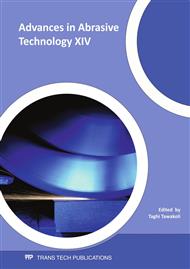p.48
p.54
p.60
p.66
p.72
p.79
p.85
p.91
p.97
Modeling of Specific Grinding Energy Based on Wheel Topography
Abstract:
Grinding performance is evaluated mainly in terms of specific grinding energy. The number of active grits per unit area and their slope is considered as the two grinding wheel topographical key parameters for studying grinding performance. To provide a view on how various parameters influence specific energy and the importance of wheel topography and grit workpiece interaction, a specific grinding energy model is developed. Inputs to this model are workpiece parameters, grinding process parameters, and, in particular, the grinding wheel topographical parameters. This model has been validated by experimental results. The theoretical values considering the complexity of the grinding process reasonably compare with the experimental results. The effect of number of active grits per unit area and their slope on specific grinding energy and then metal removal mechanism is investigated. The results revealed that the number of active grits per unit area has less effect on specific grinding energy than grits slope.
Info:
Periodical:
Pages:
72-78
Citation:
Online since:
August 2011
Authors:
Keywords:
Price:
Сopyright:
© 2011 Trans Tech Publications Ltd. All Rights Reserved
Share:
Citation:


